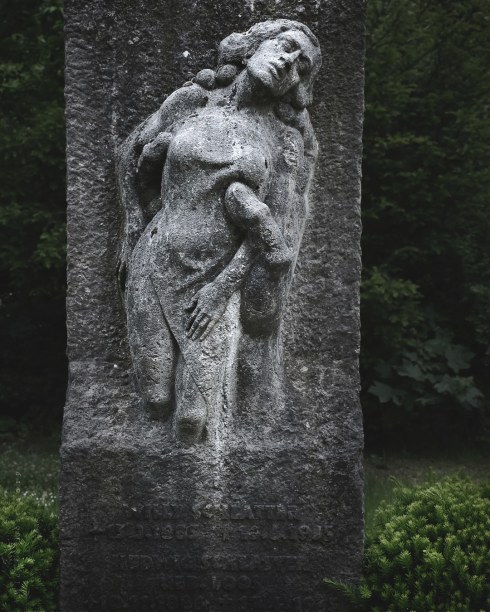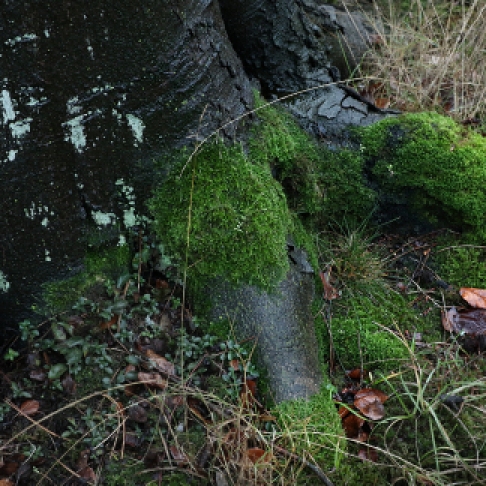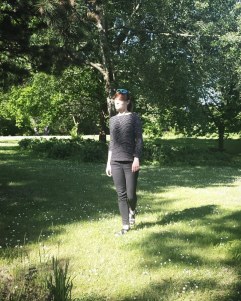First, fluctuating impressions for 2020… later we went to see “Motherless Brooklyn” at one of the Filmkunstkinos here in Düsseldorf. I like films, where one can actually focus on the characters and remember the story afterwards. This was such a film. Edward Norton is a little genius.
World Goth Day, Observation and Contemplation
23 MayAnother exploration of Düsseldorf’s Nordfriedhof, in the twilight of the evening hour and short before rain set in.
The graveyard is the closest nearby place, where I can enjoy a bit of calm and solitude. There are wild parts, reminiscent of English landscape gardens, which occur quite magical to the senses. On the other hand, the majority of graves is fostered with an accuracy resembling that of miniature baroque gardens. The ballast bed trend is also taking over people’s last place of rest. There are exceptions, with lush planting gone wild, such as the grave covered in columbine, which is pictured above.
The caretakers seem to employ ecological concepts and care for biodiversity. E.g. I found an abandoned sandy part, previously covered in black nightshade, and now filled with fragrant phacelia, which is a soil conditioner and attracts a multitude of pollinating insects, not only honey bees. There are bee hives being implemented on this graveyard. There is a small pond visited by various water fowl as well grey herons and I spotted at least one large bird of prey, a common buzzard. The entrance on one side smells heavily like fox. There is a huge population of rabbits digging burrows all across the graveyard, which is probably not to the liking of all bereaved, but partly amusing to observe.
There is an abundance of large and impressive family grave sites as well as memorials for the victims of WWI and WWII. The annexed stonemason does an admirable job with the restoration of the historical grave sites.
It is easy to become enticed by the romanticism conveyed through the abundance and sheer beauty of the place and its funerary art.
As much as I am occupied with the topic of death and the dead, I am part of a generation that will likely not enjoy the luxury of such post-mortem vanity. In truth, it has always been only a small part of humanity to take part in such luxury. Further, the fate of today’s youth is likely, to dissolve into spirit and not leaving much traces of physical existence behind. The larger mankind grows, the less space it will have for its exponentially growing amount of bodies. Neither are the monuments built over decades to last forever. However, they help to implement and strengthen the status of a few over a certain period.
2 centuries of opulent European grave culture, between the modern world and the past, between ego obsessions and spiritual ideals, between emotions and the need for detachment. A boundary between, and – perhaps most importantly – a place for old trees and a green lung for an ever expanding urban space.
Garden and Park Schloss Berge, Gelsenkirchen
8 May
An epic English landscape garden, a herb garden to drive the witch crazy and a romantic French garden – all in one place. Who thought Gelsenkirchen was so beautiful?
The park and gardens at Schloss Berge (Gelsenkirchen) offer interesting perspectives. Portals formed by trees frame and reveal new scenes. High beechwood hedges flank the way into a labyrinth. Staggered arrangements emphasize distances. The area around the former castle is divided into three sections: the French garden with its geometrical flower borders and allegorical sculptures was created during the late baroque period, whereas the widespread English landscape garden was added during the 18th century. Between the two lies a labyrinth, which encloses a lavishly laid out herb garden with espalier fruit trees and plenty of healing herbs.
Fellow photographer Anna Krajewski guided me through this wonderful park, while walking her English bulldog. Mist veiled the nature and buildings and provided a chill and relaxed atmosphere. And so the three of us enjoyed the cool day, after an eventful Walpurgis night…
French Garden
The first garden at Schloss Berge…
View original post 506 more words
Kamelienblüte Schloss Pillnitz, Frühlingsanfang 2019
22 MarThe camellia in Pillnitz is around 230 years old, almost 9 m high and 11 m in diameter. From February to April it is covered in carmine red flowers. During the cold season, the tree, which was planted in 1801 by court gardener Terscheck, is protected by a large glass house with stairs. During this time visitors can enter and view the tree from two levels.
In the mid 19th century Dresden became a European hot spot for the culture and breeding of camellias, and exported them to Russia as well as Italy and Spain. The camellia was viewed as a status symbol among European aristocrats, and Russians in particular, had a high demand for camellia flowers, which were exported in thousands to St. Petersburg and Moscow.
With growing popularity among Westerners, and contrary to its Far Eastern symbolism, the meaning of the flower changed. Thanks to popular literature, most prominently La dame aux camélias by Alexandre Dumas from 1848, as well as real life personae, such as the “Wiener Cameliendame”, a dancer named Fanny Elßler, the camellia became erotizised!
On the other hand the longevity of the flowers, and particularly white camellia flowers, became associated with death and mourning and were woven into funeral wreaths.
The seeds of all known (about 200) camellia seeds yield a valuable oil, which smoothes the hair and juvenates the skin. The oil is rich in linolenic acid, and is also used in cooking and reduces cholesterine. Samurai rubbed camellia oil unto their sword blades to protect them from rust. The oil is also used as a natural surface finish for wood, as lube in watches and precision engineering and more.
Camellia wood is hard and durable and was used in the manufacture of weapons, different tools as well as kokeshi dolls. Up to the Edo period, a camellia rod was used in Buddhist ceremony to punish and drive out malign spirits. The wood also yielded a spark-free and, hence sought after charcoal.
Camellias are highly resistant against diseases and may contain different antibacterial and fungicidal agents.
Besides, the first Westerner to portrait a camellia flower was likely a Saxon gardener by the name George Meister. His book “Der Orientalisch-Indianische Kunst- und Lust-Gärtner” was published in 1692 in Dresden. In it he describes both the camellia as well as its crop plant, Camellia sinensis var. sinensis – the tea shrub!
Further Reading:
https://de.wikipedia.org/wiki/Pillnitzer_Kamelie
https://www.schlosspillnitz.de/de/schloss-park-pillnitz/kamelie/
Japanischer Garten / Nordpark, Düsseldorf
3 May- Japanischer Garten Düsseldorf
- Nordpark Düsseldorf
- Nordpark Düsseldorf
3 weeks ago I moved to Düsseldorf. One of the first things we explored was the Nordpark and Japanischer Garten, while the cherry trees were still in bloom.
Abandoned Park in Spring – The Fuming Womb
11 AprOld ash and yew trees in an abandoned park from the 19th century
The trees grow atop arranged rocks, underneath is hidden a small cave. The park’s landscape has once been planned carefully and in alignment with prominent buildings, such as the steeple of the Auferstehungskirche. Channels once lead water through the protracted park scape, which stretches along the Weißeritz river. Most of the paths and arranged parts are overgrown and the original park’s landscape is only slowly re-emerging, due to the thoughtful work of conservationists. Thus are revealed oddities such as gnarly, half dead – half alive trees and previously hidden pathways…
Herbs such as hollowroot (Corydalis cava), wood squill (Scilla sibirica) and thimbleweed (Anemone nemorosa) are currently in bloom, covering the grounds in purple, blue and white. As the sun was setting, I did an incense offering between the base of the stems of two ash trees, which are merged by their roots, observing the smoke rising from the womb formed between both trees and watching the sun go down…




























































